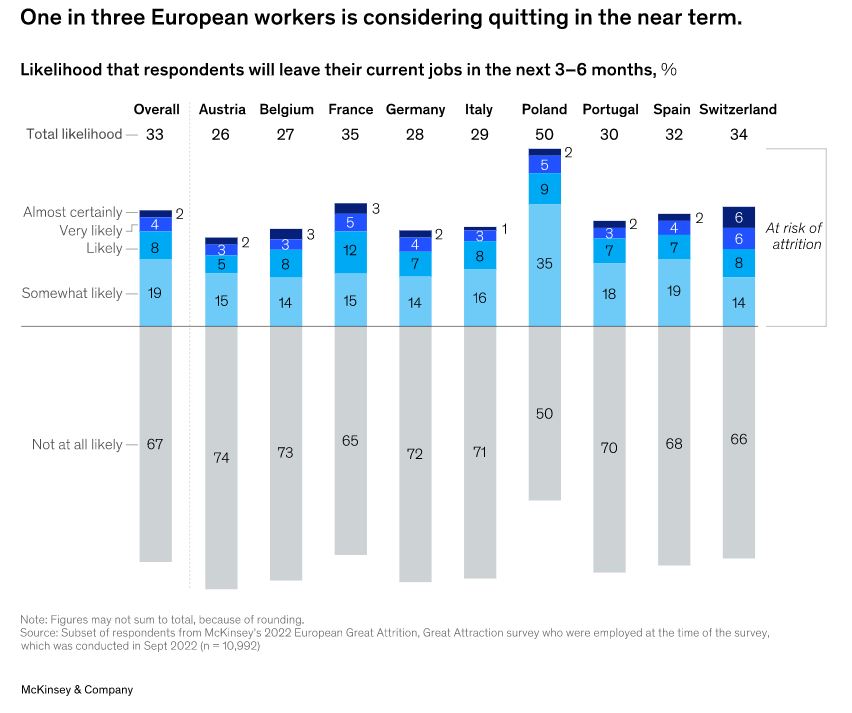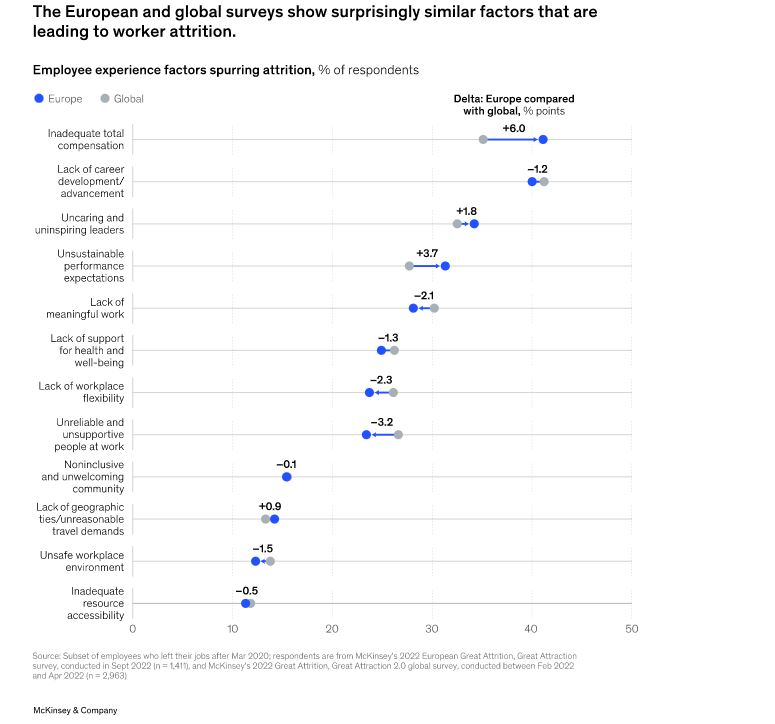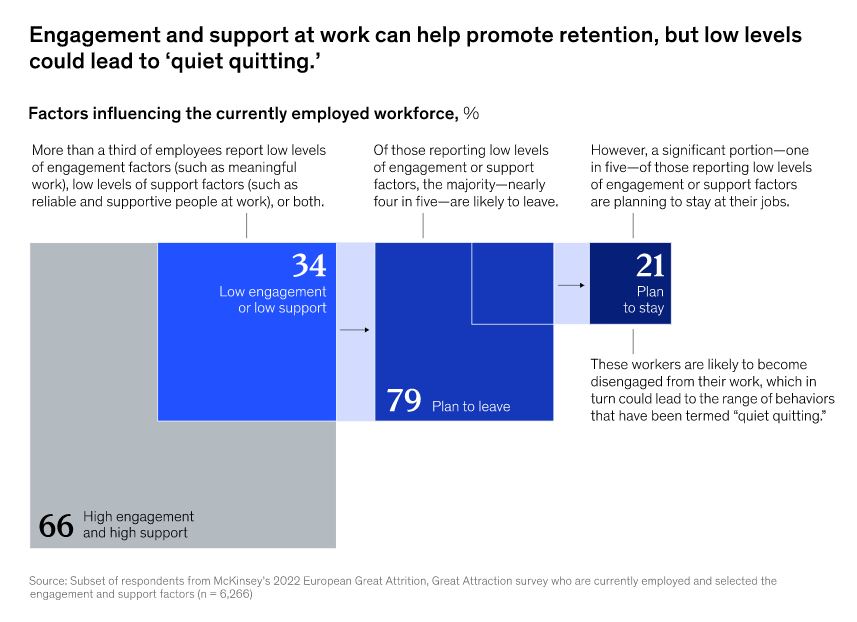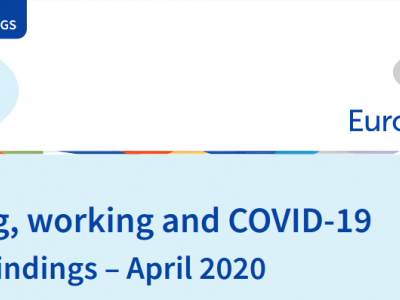European talent is ready to walk out the door. How should companies respond?
European talent is ready to walk out the door. How should companies respond?

How do companies keep their current workforces happy while drawing the best people to join them? Talent leaders have been asking that question forever, of course, but the answers have grown much more complex since the COVID-19 pandemic set off an employee exodus that has shaken organizations across the globe.
McKinsey has analyzed this Great Attrition talent trend in depth, showing why people began quitting in droves and how companies, caught unaware, could respond.1 We updated our research earlier this year, finding that workers were not only still quitting but also switching roles and industries, in what we dubbed the Great Renegotiation.2 We offered ideas for how organizations could look to different employee groups to help fill jobs.
Now, we turn to Europe, where the destabilizing war in Ukraine, rising inflation, and growing fears of hiring freezes and job losses have created a difficult set of conditions for companies. We wanted to know if the talent trends we’ve followed for the past two years in the United States and other countries are having a similar effect in Europe. The answer is a resounding yes. Companies can’t get the people they need, and they are losing the workers they already have, while falling behind in areas such as technology and innovation that affect the region’s long-term competitiveness.3
About the research
Our new analysis, which includes a survey of more than 16,000 respondents in nine European countries, shows that fully one-third of respondents say that they expect to quit their jobs in the next three to six months (see sidebar, “About the research”). While that slice of the workforce is lower than the 40 percent in our global survey from April,4 it is a remarkably high churn rate for Europe, where labor protections and cultural factors—not to mention a likely economic slowdown—tend to favor remaining in a job. Companies that believe attrition is a problem limited to the United States should understand that one in three of their workers may quit over the near term.
Yet high attrition is just one of the challenges facing European employers. The job vacancy rate has almost doubled, to 3 percent in June 2022, from 1.6 percent in June 2020,5 making it harder for companies to fill open positions. Organizations also face a skills gap across industries, as well as a high number of retirees who are unlikely to return to the workforce.
At the same time, European employers have an opportunity to sharpen their value proposition. They can use this moment to address chronic, systemic talent issues by offering adequate compensation, career advancement, and caring leaders, while also focusing on more recent employee needs born of the pandemic. In this article, we analyze our new data to show how companies can retain those who are considering leaving, provide support to turn “quiet quitters” into more engaged employees, and recruit top talent more effectively to build a productive workforce that can deliver in times of radical uncertainty.
The European talent landscape: Top reasons for leaving reflect shifting employee values
Our survey revealed a consistent rate of attrition, at about a third of respondents. The outlier was Poland, where half the people say that they are at least somewhat likely to leave their jobs in the next three to six months (Exhibit 1).6
Exhibit 1
That this many workers are considering leaving revealed a dramatic level of attrition for Europe, where labor protections are more extensive than in other countries. Retirement, too, is often a milestone to look forward to because of pensions and a robust social safety net. Our survey showed that 24 percent of Europeans have retired (early or of natural age) in the past seven years. In contrast with the United States, retirees in Europe aren’t as interested in returning to work for the right offer. When they do retire, they’re more likely to be gone for good7—reducing the pool of potential workers for European employers.
This large number of people eyeing the exits is not much lower than the 40 percent in our earlier sample of six countries. In fact, when comparing vastly different labor markets and staggered time frames—April for the global data and September for Europe—and factoring in worsening economic conditions, we see similar attrition rates. That’s not a favorable environment for European companies looking to keep and attract workers.
Despite the structural and perceived differences in the European labor market, we unexpectedly found that the top three reasons Europeans give for leaving their jobs are similar to those of our global sample: inadequate compensation, lack of career development and advancement, and uncaring and uninspiring leaders (Exhibit 2).
Exhibit 2
Fair compensation and having a clear career path are perennial top motivators for workers in any job. We consider compensation table stakes because it’s enough to buy you a seat at the table but not enough to give you a winning hand. A lack of caring leaders, also a consistent reason for why people across countries quit their jobs, has grown in importance since the pandemic began. The similarities in top quitting factors across regions and time periods show that the pandemic has normalized these employee attitudes across segments of workers.
People across age groups and experience levels are putting more emphasis on whether these factors in combination are enough to make them want to stay at an organization for the long term. They need tangible and consistent proof that they have a positive future—in other words, the whole package: compensation, caring leaders, advancement. The fact that a large number of Europeans are saying, “I need a job, but I don’t need your job,” is a clear sign of this new emphasis.
Meanwhile, other factors have grown in importance for European respondents since the pandemic began, particularly those related to unreliable and unsupportive people at work, as well as a noninclusive and unwelcoming community.
The emphasis on these relational “people factors” marks a notable mindset shift among European workers. More than ever, employees say that they need to feel engaged and supported in an inclusive and welcoming environment. Unsustainable work expectations and a lack of support for employee well-being in particular align with rates of employee burnout that McKinsey research shows are at all-time highs.8
We also found that the reasons employees are considering changing jobs are remarkably consistent across European countries. The top two factors in every country are inadequate compensation and insufficient career advancement. But relational factors also rank highly, including having uncaring and uninspiring leaders and unsupportive coworkers.
Focus on the whole workforce (the happy, the unhappy, and the in-between)
Most Europeans in our sample say that they intend to stay on the job, and their motivations shade differently than those of their exiting counterparts. Compensation is a top reason here as well, but it is more of a hygiene factor than anything else. Motivators include flexibility, meaningful work, and supportive coworkers—once again, an endorsement of factors that have grown in importance for Europeans during the pandemic.
People stay in a job for the opposite reasons than they leave it: because they are rewarded adequately, their needs for advancement and skill building are met, and they see a future for themselves. What sets Europeans apart, though, is the degree to which they prize a safe workplace environment; that factor is in the top three for Europeans, while it is eighth overall for the global group (Exhibit 3). Reasons for that include the fact that many COVID-19 restrictions ended over the summer, leading employees to worry about how safe they would be back in the office and whether they wanted to be back at all.
Exhibit 3
Companies must continue to deliver on flexibility if they want to retain people who have not yet indicated a willingness to leave. Throughout the pandemic, employees—ranging from working parents to younger folks just starting out to workers nearing retirement age—all say that they want more control over their working hours so that they can better balance life and career.9
This raises a crucial point: in crafting an alluring employee experience, European organizations have to avoid falling into the trap of focusing solely on the workers who are unhappy enough to quit over the short term. Of course, it’s essential to retain them, but companies also need to be sure that the majority who aren’t indicating that they are leaving don’t move into that category.
In other words, leaders have to care about retaining talent before they can start to think about those who are walking out the door. Making the organization sticky, which we discuss below, is part of that active investment in the entire workforce.
The sound of ‘quiet quitting’
To help assess all their workers, companies can group their employees in four broad categories—those who are happy with their job but are considering better options, those leaving because they dislike their job, those staying because they’re happy, and those who are passively staying but who don’t really want to be there. This last group consists of “quiet quitters,” or members of the employed-yet-disengaged workforce.10
European employers, like organizations everywhere now, face the problem of workers who leave—and workers who stay but who might act like they have already left. Our research shows that in Europe, the majority (79 percent) of those reporting low levels of engagement or support factors are likely to leave. However, a small but significant portion (21 percent) of those reporting low levels of engagement or support factors are planning to stay at their jobs. Although these employees aren’t quitting, they are likely to become disengaged from their work, which could manifest as withdrawal from or neglect of their duties.
If we do the math, with one-third leaving and one-fifth of those who remain falling into the ranks of those not necessarily working to pace, that adds up to about 44 percent of the workforce. Clearly, that number of dissatisfied employees is not sustainable in a healthy organization.
Some employers believe that quiet quitting is just a phase, but there are two reasons to discount that. One is that despite the trendy name, quiet quitters have been around forever—as people whose level of engagement is below what managers might want. The other is that in a predicted economic downturn, when companies are often forced to turn to hiring freezes or job cuts, they will need the workforce that remains to be that much more productive.
Quiet quitting is not just an individual problem, it’s a mutual responsibility between the employee who is disengaged and the organization that isn’t offering enough support. Both higher engagement and higher support are needed to solve this problem.
An overwhelming majority of employees who report high levels of engagement factors (such as finding meaning in their work) and support factors (such as reliable and supportive people at work) are likely to stay at their jobs and be productive in them (Exhibit 4).
Exhibit 4
The (new) value system: Emphasize personal development and recognition to reward workers
Europe’s labor market is unique, with stronger worker protections, more extensive pension offerings, and longer parental leaves, to name but a few examples that benefit employees—and society writ large. Culturally, workers in this region don’t leave their jobs as often as those in the United States and other countries do.
However, with an aging population and a darkening economic picture, European employers face a complex environment in which to operate. This calls for more creative solutions. Companies can draw inspiration from the way other organizations, even those in other regions, are attempting to solve the problem that attrition brings. They can find novel ways to attract younger people to jobs and keep the workers they have feeling more engaged and productive.
Here are five ways that European companies can be proactive about retention, reinforce a healthy working environment, and look beyond traditional recruitment pools.
Address the attrition
The first step is to turn inward. Companies should take stock of the attrition they have already experienced and move to reduce further quitting by addressing what is motivating their employees. Our European data shows that the reasons people have left a job and why they plan to leave are the same, so companies can get ahead of the next wave of attrition by understanding why others have already left. Employers should consider doubling down on providing adequate total compensation packages, investing in employees’ development, and providing meaningful advancement opportunities, while showing more caring and inspiring day-to-day and strategic leadership.
Don’t overlook ‘the others’
When companies focus mostly on attrition and attraction, they tend to overlook the need to actively support workers who are staying. Sticky companies anticipate and address employees’ concerns. They ask people what they need to be successful in their roles—and they listen to the answers. They push people to grow in their jobs and encourage a growth mindset throughout the organization. Based on feedback, these companies might innovate jobs, teams, or hiring practices. They are not afraid to provide the flexibility that employees need to create a work–life balance that helps keep workers engaged and productive. These cultural factors help make a company more attractive to join and, ideally, provide more incentives for employees to stay and remain engaged. They can also reengage those who are quietly quitting.
Reward loyalty by building capabilities
Career advancement is a top priority for European workers. A company that rewards its employees by investing in their development reduces their incentive to look elsewhere while also increasing overall engagement. With that in mind, leaders can start by rewarding those who are already inside the company with career development and advancement opportunities. This investment in the workforce is based on gratitude and trust, highlighting that past work is valued and that the company believes in their employees’ ability to deliver the future work that builds value. Then, leaders can look outside the company to deliberately find the talent that they still need. In the broader context, Europe is experiencing a widening gap in technology, innovation, and corporate performance compared with other regions. With recent headlines of job losses in the technology sector, companies that need to expand their tech expertise could look to those who are newly available. However, companies should also focus on using the right levers to prevent those potential hires from going to a nontraditional job, or worse, to the competition.
Rethink the corporate culture
Since the start of the pandemic, organizations have been striving to help employees who are burned out. However, it’s crucial to focus on affirmative behaviors so that burnout doesn’t become a problem to begin with. Once it takes hold, even the most well-intentioned remediation efforts (or yoga classes) won’t fix the problem. As our survey data shows, European workers now emphasize other factors when it comes to a satisfying employee experience. They want more workplace flexibility and a physically and psychologically safe workplace.11 McKinsey research shows that caring managers can also make a huge difference in engagement by reaching out more frequently and honing in on what excites employees and gives them a sense of purpose.
Think outside the (recruitment) box
The existing talent pools of traditional workers in an aging market are not sufficient to replenish those who have retired. European organizations will need to go after those who have left the traditional workforce, including people who are self-employed, those in the gig economy or not currently in full-time corporate jobs, younger people just entering the workforce, and those who are considering retirement. Because these groups emphasize different factors (with older workers wanting more caring leaders and younger people valuing strong support networks), companies must target these groups differently. And while these pools of workers may be smaller in Europe than they are in the United States, for example, they’re out there, and companies can go get them.
The European workforce is not immune to the attrition trend we’ve seen sweep across countries over the past several years. The mindsets of European employees have changed since the pandemic began, and many are no longer willing to stay at organizations that don’t value their contributions or offer a future that excites them. Now more than ever, companies should demonstrate a commitment that is both widespread and targeted to individuals—a commitment that is core to their health and future growth.












